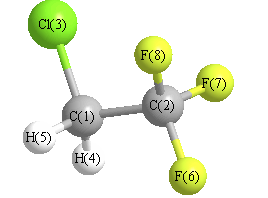Vibrational Frequencies calculated at CCSD/cc-pVDZ
| Mode Number |
Symmetry |
Frequency
(cm-1) |
Scaled Frequency
(cm-1) |
IR Intensities
(km mol-1) |
Raman Act
(Å4/u) |
Dep P |
Dep U |
|---|
| 1 |
A' |
3137 |
2972 |
8.66 |
|
|
|
| 2 |
A' |
1476 |
1398 |
31.75 |
|
|
|
| 3 |
A' |
1395 |
1322 |
105.95 |
|
|
|
| 4 |
A' |
1319 |
1249 |
130.22 |
|
|
|
| 5 |
A' |
1218 |
1154 |
242.07 |
|
|
|
| 6 |
A' |
880 |
834 |
23.69 |
|
|
|
| 7 |
A' |
817 |
774 |
20.61 |
|
|
|
| 8 |
A' |
651 |
616 |
28.31 |
|
|
|
| 9 |
A' |
546 |
517 |
6.81 |
|
|
|
| 10 |
A' |
362 |
343 |
0.51 |
|
|
|
| 11 |
A' |
187 |
177 |
1.62 |
|
|
|
| 12 |
A" |
3208 |
3039 |
0.75 |
|
|
|
| 13 |
A" |
1350 |
1279 |
197.80 |
|
|
|
| 14 |
A" |
1147 |
1087 |
80.79 |
|
|
|
| 15 |
A" |
926 |
877 |
7.79 |
|
|
|
| 16 |
A" |
543 |
514 |
2.79 |
|
|
|
| 17 |
A" |
353 |
334 |
0.78 |
|
|
|
| 18 |
A" |
100 |
95 |
2.95 |
|
|
|
Unscaled Zero Point Vibrational Energy (zpe) 9806.7 cm
-1
Scaled (by 0.9473) Zero Point Vibrational Energy (zpe) 9289.9 cm
-1
See section
III.C.1 List or set vibrational scaling factors
to change the scale factors used here.
See section
III.C.2
Calculate a vibrational scaling factor for a given set of molecules
to determine the least squares best scaling factor.
